The digital terrain has changed dramatically; video content is clearly going to be the main platform for audience participation in 2025. Brands and content providers are finding that video’s immersive qualities offer unmatched chances to interact with viewers as attention spans continue to break and competition for eyes becomes more fierce.
This development is significantly changing people’s interactions with companies, knowledge absorption, and decision-making; it goes far beyond basic consumption measurements.
Examining new trends, successful tactics, and technological advances driving this change, this paper investigates the transforming power of video content on audience involvement.
The Development of Video Engagement
From passive watching to interactive experiences, video engagement has changed to include audience involvement enhanced by polls, Q&A, and live streaming.
Watch time and engagement metrics increasingly take the front stage on platforms, which motivates artists to create engaging, value-driven work.
From Passive Observation to Active Participation
From the times of passive watching, the idea of video interaction has changed drastically. The audience of today expects to engage with video material in significant ways, therefore establishing a two-way interaction between producers and consumers.
With engagement rates rising by up to 47% when interactive components such as polls, quizzes, and clickable overlays are included, interactive elements have turned films from monologues into discussions.
Video Ecosystems on Multiple Platforms
Integrated ecosystems across several platforms have replaced the compartmentalized approach to video content.
Effective artists now create video plans that consider the unique qualities of every platform while preserving consistent messages across media.
Short-form videos on sites like Tiktok and Instagram act as gateways to lengthier material on YouTube or sponsored websites, therefore generating engagement funnels that lead viewers across deeper experiences.
Strategic Strategies for Video Involvement
Good video engagement techniques call to action or viewer polls and use powerful hooks in the opening few seconds.
Regularly evaluating audience retention statistics helps improve material for the most impact and ongoing viewer engagement.
Audience Segmentation: In Use
Extreme audience segmentation is currently the most successful video technique as it produces customized content for ever smaller audience groups.

Effective producers create micro-targeted material targeting particular pain spots, hobbies, and demographic features rather than generic films meant for wide appeal.
In B2B environments, where conversion rates have risen by up to 42% when films address very specialized sector concerns, this strategy has been especially successful.
Format-Audience Alignment
Various viewers find certain video formats more appealing. Professional audiences, for example, usually interact more closely with webinars and demonstration materials, whereas younger groups show higher tastes for short-form narrative storytelling.
Knowing these relationships helps producers to match formats to audience segments, hence maximizing involvement all around.
Technique of Immersion Storytelling
Immersive narrative strategies include rich imagery, dynamic pace, and emotional connections to really engage viewers in the tale.
Including first-person viewpoints, sound design, and interactive components increases involvement and helps the experience to be remembered.
Video Design Using Narrative Psychology
The most interesting videos make emotional connections with viewers by using narrative psychology.
Research has demonstrated that movies using well-structured narrative patterns produce 22% better completion rates, and this strategy focuses on developing emotional arcs inside the material.
The best videos set emotional stakes early, build suspense by pointing out specific issues, and then provide resolution by means of clear value propositions.
Optimization of Visual Language
Effective video producers create consistent visual languages that maximize interaction and support brand identity.
This covers deliberate use of visual pace, composition approaches, and color psychology.
Studies show that films with consistent visual languages are 27% more likely to be remembered and 31% more likely to inspire action than those with contradicting visual styles.
Modern Video Engagement Enhancement
Advanced video engagement optimization is the use of data-driven insights to improve content strategies by means of audience retention metric analysis and subsequent content strategy adjustment of pace.
Using interactive components such as surveys, Q&A sections, and clickable overlays keeps viewers interested and promotes more thorough participation.
AI-powered Personalization
Video personalizing has been revolutionized by artificial intelligence outside basic suggestion systems. Dynamic content assembly nowadays lets films be dynamically rebuilt depending on audience traits and behavior patterns.
With hundreds of possible variants from a single content base made possible by this technology, every viewer will get a specifically improved experience.
Early users of dynamic video systems powered by artificial intelligence estimate engagement levels of up to 64%.
Real-time Analytics for Engagement
Real-time analytics included in most advanced video methods today allow instantaneous content optimization.

While sentiment analysis tools track emotional reactions across films, heat mapping technology finds particular events when viewer interest peaks or declines.
These realizations enable quick iteration, with effective producers always improving material depending on detailed interaction data.
Using sponsored platforms to boost natural engagement helps artists to reach more people and analyze real-time data to adjust their content strategy, therefore guaranteeing continuous audience development and interaction.
Integration between Cross-Reality Videos
With augmented and virtual reality components being included in popular media tactics, the lines separating standard video from immersive technology are blurring.
Beyond first video watching, QR codes connecting to AR experiences, 360-degree video components, and VR companion pieces enable prolonged interaction options.
Product demos and instructional materials have especially benefited from this cross-reality approach; studies showed 43% better knowledge retention when conventional films are augmented with immersive components.
Final Thoughts
The key pillar of digital communication strategies in 2025 will be video content, whose influence on audience engagement goes well beyond basic views and likes.
Success will more and more go to those who regard video not just as material to be consumed but also as experiences to be experienced and shared as the media changes.
Brands and artists may establish closer ties with their consumers by adopting smart targeting, immersive storytelling approaches, and sophisticated optimization techniques, therefore fostering not just engagement but also long-lasting relationship development.
Source
https://councils.forbes.com/blog/the-rise-of-video-content-in-digital-marketing


More Stories
Casinos Not on GamBlock (2025): Bypassing Blocks, Reclaiming Control
Personalized Mother’s Day Gifts That Are Trending for All the Right Reasons
The Hidden Risks of DIY TV Wall Mounting